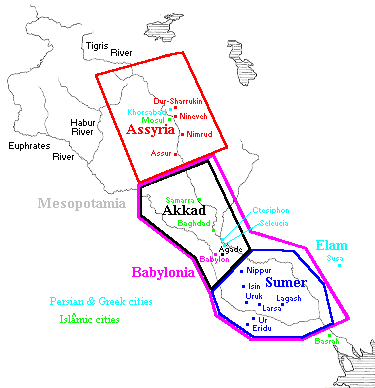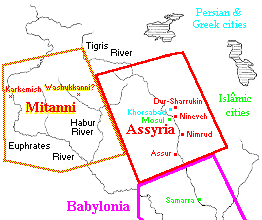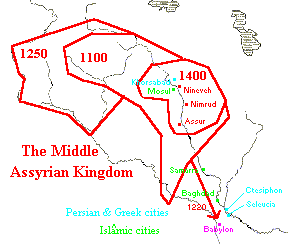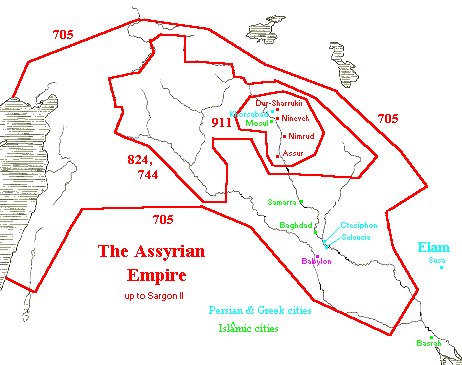| |
Assyrians
The Assyrians are the people of ancient Mesopotamia,
succeeding the Sumero-Akkadians and the Babylonians as one continuous
civilization. The core of the Assyrian Empire of antiquity encompasses the areas
of Northern Iraq, North-Western Iran, South-Eastern Turkey and North-Eastern
Syria, and Lebanon.
Old Assyrian Period
|
Assyria: Old Assyrian Period |
| Ushpia, Sulili |
c.2020,
not attested |
| Kikkia |
| Akiya |
| Puzur-Ashur I |
c.1975-c.1939 |
| Shallim-ahhê |
| Ilushuma |
| Erishum I |
1939-1900, or
c.1906-1867 |
| Ikûnum |
1900-1814 |
Sharu-kîn I,
Sargon I |
| Puzur-Ashur II |
| Naram-Sîn |
| Erishum II |
| Shamshi-Adad I |
1813-1781, or
1809-1776 |
Expands west and south
to the Eurphrates |
| Ishme-Dagan |
1780-1741 |
| Invasion by Hammurabi, 1760 |
| Mut-ashkur |
|
| Rimush |
|
| Asinum |
|
| Puzur-Sîn |
|
| [six kings] |
|
| Adari |
c.1700 |
The city state of Ashur appears in history in the early days of the Isin-Larsa period. Its first distinguishing characteristic is as the center of a system of trade, with Assyrian merchant communities attested deep into Anatolia. The state briefly expands to empire proportions under Shamshi-Adad I -- himself of Amorite origin, like the contemporaneous Dynasty I of Babylon -- but then is rapidly reduced again. Subordination to Babylon and then domination by the Hurrians and Mitanni keep Assyrian within its limits, and its history unimpressive, for some time.

The invasion and domination or conquest of Ashur by Hammurabi's Babylon leads to one of the more obscure periods in Assyrian history. Thus, the Old Assyrian Period leaves us with little hint of the conquerors that the Assyrians would later become. Already, however, the Akkadian language of Assyria emerges as a distinct dialect, as it will continue until the fall of Nineveh. Beyond the expanse of traditional Sumer and Akkad, Assyria is a frontier region whose rigors at the crossroads of conquest perhaps explain the toughening of the people to a military discipline that later would seem unbeatable. In subsequent treatment here, Babylonian and Assyria history are separated. They do go their own ways, but it should be kept in mind that they represent two sides of the same civilization, with well remembered roots in Sumer. We might say that Babylon represents the Greek side of the tradition, with a sophistication that was passed down to, indeed, the Greeks, and Assyria the Roman, creating the first transcontinental empire (since it extended up the Nile) in the Middle East.
i
Kings of Assyria
|
Kings of Assyria |
| Bęlu-bâni |
1700-1691 |
| Libaia |
1690-1674 |
|
Hurrian occupation, c.1680 |
| Sharma-Adad I |
1673-1662 |
| IPtar-Sîn |
1661-1650 |
| Bazaira |
1649-1662 |
| Lullaia |
1621-1618 |
| Kidin-Ninua |
1615-1602 |
| Sharma-Adad II |
1601 |
| Erishum III |
1598-1586 |
| Shamshi-Adad II |
1585-1580 |
| Erishum III |
|
| Shamshi-Adad II |
|
| Ishme-Dagan II |
|
| Shamshi-Adad III |
|
| Ashur-nirâri I |
1547-1522 |
| Puzur-Ashur III |
1521-1498 |
| Enlil-nas.ir I |
|
| Nűr-ili |
|
|
Control by Mitanni |
| Ashur-râbi I |
|
| Ashur-nadin-ahhę I |
|
| Enlil-nas.ir II |
|
| Ashur-Nirâri II |
|
| Ashur-bęl-nishęshu |
|
| Ashur-nadin-ahhę II |
|
Independence of Mitanni, c.1400;
Middle Assyrian Empire |
| Eriba-Adad I |
1392-1336 |
| Ashur-uballit. I |
1365-1330 |
Overthrow of Mitanni, c.1330;
Conquest of
upper
Mesopotamia, c.1300 |
| Enlil-nirâri |
1330-1319 |
| Arik-den-ili |
1319-1308 |
| Adad-nirâri I |
1307-1275 |
| Salmanasar I |
1274-1245 |
| Tukulti-Ninurta I |
1244-1208 |
|
Holds Babylon 1220-1213 |
| Ashur-nadin-apli |
|
| Ashur-nirâri III |
|
| Enlil-kudurri-us.ur |
|
| Ninurta-apal-Ekur |
1192-1180 |
| Ashur-dân I |
1179-1134 |
| Ashur-ręsh-ishi I |
1133-1116 |
| Tiglathpileser I |
1115-1077 |
|
Aramaeans appear c.1080 |
| Asharid-apal-Ekur |
1077-1074 |
| Ashur-bęl-kala |
1074-1057 |
| Shamshi-Adad IV |
1057-1050 |
| Ashur-nas.ir-pal I |
1050-1032 |
| Shalmaneser II |
1031-1020 |
| Ashur-nirâri IV |
1020-1016 |
| Ashur-râbi II |
1016-973 |
| Ashur-ręsh-ishi II |
973-967 |
| Tiglathpileser II |
967-935 |
| Ashur-dân II |
934-912 |

The list and dates here are from Georges Roux,
Ancient Iraq [Penguin, 1966, 1992, pp.507-510], with some details added from the
Historical Atlas of the Ancient World, 4,000,000-500 BC, by John Haywood [Barnes & Noble, 1998, 2000]. The chronology for the period before the
Canon of Kings, 1400 down to 700, is secured by the "Assyrian Kinglist" and a reported eclipse of the sun that can be dated to 15 June 763 BC.
This period begins with the domination of the Hurrians, already or soon to be led by a nobility of Indo-European horsemen, the
Mitanni. Assyria was at first kept in check and then in vassalage to this power, one of the more obscure but more important of the Second Millennium BC.
 Mitanni, however, set back by
Egypt, weakened after 1400 and was soon crushed between the resurgent Hittites to the west and the Assyrians to the east. The plains east of the Euphrates occuied by the
Hurrians, the Naharim (or Nahrin, "Rivers") or Jazirah ("Island"), then come under the control of the Assyrians, as they had briefly in the Old Assyrian Period. The Middle Empire reaches its height under Tukulti-Ninurta I, from 1243-1207, who holds Babylon 1220-1213 (or 1235-1227) and is the first King to use the title "King of Kings," which becomes familiar in subsequent states, down to the
Persians. This time, migrations again reduce the state. Mitanni, however, set back by
Egypt, weakened after 1400 and was soon crushed between the resurgent Hittites to the west and the Assyrians to the east. The plains east of the Euphrates occuied by the
Hurrians, the Naharim (or Nahrin, "Rivers") or Jazirah ("Island"), then come under the control of the Assyrians, as they had briefly in the Old Assyrian Period. The Middle Empire reaches its height under Tukulti-Ninurta I, from 1243-1207, who holds Babylon 1220-1213 (or 1235-1227) and is the first King to use the title "King of Kings," which becomes familiar in subsequent states, down to the
Persians. This time, migrations again reduce the state.
The Aramaeans are the ones who this time overwhelm the Jazirah and reduce Assyria to its heartland along and east of the Tigris. This is particularly fateful, since the language of the Aramaeans will eventually replace that of the Assyrians, the Babylonians, and the other
Semitic speakers in the Levant and Mesopotamia. The Amorites had been absorbed without a trace by the older civilizations, but the Aramaeans would leave the mark of their language and alphabet on the region until the Arab conquest.
i
Neo-Assyrian Empire and Political Events

The political event that still cast its shadow in the early days of Greek philosophy was the fall of the Assyrian Empire. Reduced to a small heartland by the Aramaean migrations in the 11th century, Assyria suddenly had reasserted itself under Adadnirâri II and Ashurnasirpal II. With most of the Levant and Mesopotamia taken up with small states, there was little to stand in the way of Assyria, and in short order it became the dominant power in the Middle East.
Kings of Assyria,
Neo-Assyrian
Empire |
| Adad-nirâri II |
911-891 |
| Tukulti-Ninurta II |
891-883 |
| Ashurnasirpal II |
883-859 |
| Shalmaneser III |
858-824 |
| Shamshiadad V |
823-811 |
| Adadnirâri III |
810-783 |
| Shalmaneser IV |
783-772 |
| Ashurdân III |
772-755 |
| Ashurnirâri V |
754-745 |
| Tiglathpilesser III |
744-727 |
| Shalmaneser V |
726-722 |
|
Sargonids |
| Sargon (Sharru-kîn) II |
722-705 |
| Sennacherib (Sin-ahhê-eriba) |
705-681 |
| Sack of Babylon, 689 |
| Esarhaddon (Ashur-aha-iddin) |
681-669 |
| Ashurbanipal (Ashur-ban-aplu) |
669-631 |
| DFestroys Elam, 639 |
| Ashur-etil-ilâni |
631-629 |
| Sin-shar-ishkun |
629-612 |
Asshur falls, 614
Nineveh falls, 612 |
| Ashur-uballit. II |
612-609 |
This dominance lasted slightly less than 300 years, going into
overdrive under the Sargonids in the last century. The kings used the title Shar-sharim, "king of kings," but their aspirations to universal rule, well served by the unprecedented extent of their conquests, foundered on the scale of the brutality and terror of their methods. Assyrian policy was to deal with rebellion by exemplary executions and forced relocations. By some estimates, over four million people were deported. The removal of the Cherokee Nation to Oklahoma in American history, called the "Trail of Tears," may give of sense of what this would have been like. Acts like the deportation of the Ten Tribes of Israel (by Shalmaneser V or Sargon II after the fall of Samaria in 722) culminated in Ashurbanipal's assault on and massacre of the
Elamites, which approached in effect a genocide, since the Elamites shortly thereafter disappeared from history altogether (or were assimilated with the Persians, who styled themselves rulers of an Elamite kingdom, Anshan, and who used the Elamite language in inscriptions and some records). Although Ashurbanipal himself boasted that no Elamites were left, we know from Babylonian records that there actually were. These policies sustained a vast empire for more than a century, but many subject peoples were never reconciled to Assyrian rule, and the constant campaigns of defense and punishment ultimately exhausted the Assyrians, even though they had began assimilating conquered and imported Aramaeans into their own population and army.
i

- Source
- Kelley L. Ross,
Ph.D.
|
|